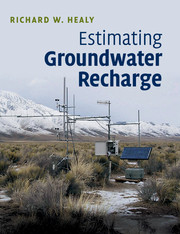Book contents
- Frontmatter
- Contents
- Preface
- Acknowledgments
- 1 Groundwater recharge
- 2 Water-budget methods
- 3 Modeling methods
- 4 Methods based on surface-water data
- 5 Physical methods: unsaturated zone
- 6 Physical methods: saturated zone
- 7 Chemical tracer methods
- 8 Heat tracer methods
- 9 Linking estimation methods to conceptual models of groundwater recharge
- References
- Index
4 - Methods based on surface-water data
Published online by Cambridge University Press: 05 April 2013
- Frontmatter
- Contents
- Preface
- Acknowledgments
- 1 Groundwater recharge
- 2 Water-budget methods
- 3 Modeling methods
- 4 Methods based on surface-water data
- 5 Physical methods: unsaturated zone
- 6 Physical methods: saturated zone
- 7 Chemical tracer methods
- 8 Heat tracer methods
- 9 Linking estimation methods to conceptual models of groundwater recharge
- References
- Index
Summary
Introduction
Streamflow data are commonly used to estimate recharge rates in humid and subhumid regions, in part because of the abundance of streamflow data and the availability of computer programs for analyzing those data. Most of the methods described in this chapter are easy to use, but application of any of the methods should be accompanied by a careful analysis of the underlying assumptions. The methods estimate exchange rates between groundwater and surface-water bodies. That exchange can represent focused recharge from a losing stream, or, as in the case of groundwater discharge to a stream, the exchange can reflect diffuse recharge that occurs over widespread areas. Some of these methods may be unfamiliar to groundwater hydrologists because they were not developed specifically for the study of groundwater recharge; instead, they were developed for purposes such as sizing of culverts and bridge openings, predicting low-flow rates in streams, or developing an understanding of stream-water quality and the ability of a stream to assimilate solutes and contaminants. The fact that base-flow or recharge estimates are generated as byproducts of these methods does not diminish the usefulness or applicability of the methods in recharge studies.
Techniques presented herein include the stream water-budget method, seepage meters, Darcy methods, streamflow duration curves, traditional streamflow hydrograph analyses (including hydrograph separation and recession-curve displacement), and chemical and isotopic hydrograph separation techniques. Some of these methods are designed specifically for estimating focused recharge; others are for estimating diffuse recharge. Discussions are centered on groundwater movement to or from streams, but the principles discussed and the methods described are equally applicable for groundwater exchange with other surface-water bodies, such as lakes, reservoirs, and wetlands. Proper application of any method requires a good conceptual model of the hydrologic system and a solid understanding of underlying assumptions. Prior to presentation of individual methods, background discussions are given on the exchange of groundwater and surface water and on the relationship between base flow and recharge. These discussions illustrate assumptions inherent to the methods and provide some guidelines for assessing the validity of those assumptions.
- Type
- Chapter
- Information
- Estimating Groundwater Recharge , pp. 74 - 96Publisher: Cambridge University PressPrint publication year: 2010



